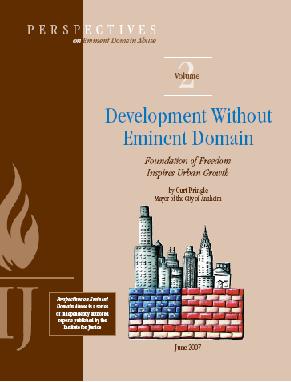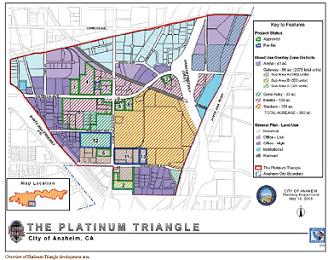 The Castle Coalition, a project of the Institute for Justice recently released a report written by Anaheim Mayor Curt Pringle on how cities can grow, even in their urban cores, without the use of eminent domain.
The Castle Coalition, a project of the Institute for Justice recently released a report written by Anaheim Mayor Curt Pringle on how cities can grow, even in their urban cores, without the use of eminent domain.
Pringle and Anaheim are the model for this sort of activity with their highly successful Platinum Triangle development centered around the city’s baseball stadium. But Anaheim has also had similar success in redeveloping its downtown, again without the use of any government taking or the threat of taking.
Anaheim does not have a corner on the market for urban infill. In fact in Irvine there is a similarly significant activity with private land owners recognizing the value they can reap from changing land uses and building up. Irvine too has resisted the temptation to use the heavy hand of government to build a more cohesive plan, but rather allow the market place to drive change and assist, guide, maybe prod a little bit to help effectuate the outcome.
Other cities like Brea in Orange County have used every evil of government to make their downtown "prettier." They have used not only eminent domain, but also they have taken on massive amounts of redevelopment debt in order to drive a finished product that could not survive on it’s own without substantial government assistance/intervention.
Back in Anaheim, Mayor Pringle and indeed his council colleagues: Harry Sidhu, Lucille Kring, Lori Galloway and Bob Hernandez each made a conscious decision that the taking of land from property owners was not a viable option or at least not one that was appropriate. And as it turns out, no only were they right, but they ended up with a dynamic plan and revitalized urban core that would rival any other big city.
By being flexible with development standards, not safety related standards, but restrictions like height, parking and density, the city put the burden on the developers to prove their proposals were viable rather than use a set standard template imposed by the city.
 One interesting outcome of Anaheim’s plan is that there are now thousands of affordable housing units in Anaheim. These are not affordable in the traditional sense where government guarantees bonds or a not-for-profit corporation takes ownership of the units. But rather since significant density was achieved, the developers themselves are able to sell the condos, flats, brownstones, etc. at reasonable prices as to allow families and younger workers to afford to buy their first home.
One interesting outcome of Anaheim’s plan is that there are now thousands of affordable housing units in Anaheim. These are not affordable in the traditional sense where government guarantees bonds or a not-for-profit corporation takes ownership of the units. But rather since significant density was achieved, the developers themselves are able to sell the condos, flats, brownstones, etc. at reasonable prices as to allow families and younger workers to afford to buy their first home.
We aren’t talking Kansas home prices but in Orange County where housing prices put the average single family home out of reach of many first time home buyers, a mid-$300,000 price tag for a condo in Anaheim’s new revitalized urban core is pretty attractive.
So the next time you see a local elected official talk about E. D. and there isn’t a little blue pill involved, send them the link to Mayor Pringle’s report on how it’s done the right way. Or have them give any one of the Anaheim City Council Members a call, because even though they don’t always agree on everything, they agreed on never taking something that isn’t theirs–the mayor and his council colleagues are great examples for the rest of us.

